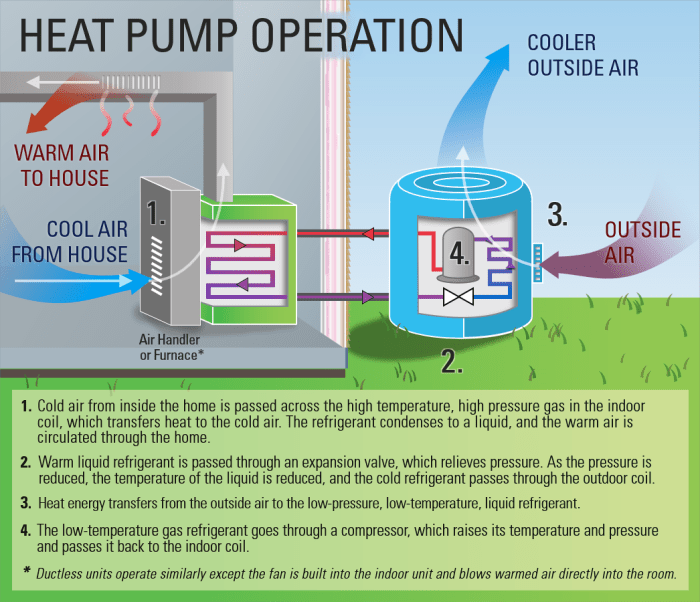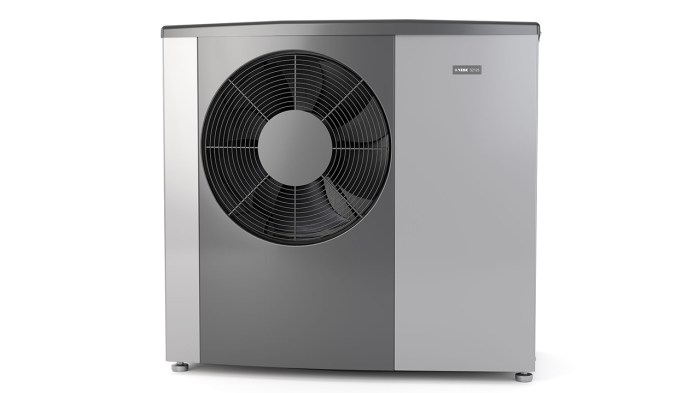How is heat pump heating seasonal performance factor hspf calculated – How is heat pump heating seasonal performance factor (HSPF) calculated? This article delves into the intricacies of HSPF, exploring its purpose, calculation methodology, and applications. By understanding HSPF, homeowners and industry professionals can make informed decisions about heat pump selection and installation.
HSPF is a standardized metric used to measure the efficiency of heat pumps. It reflects the heat pump’s ability to provide heating over a typical heating season. A higher HSPF indicates a more efficient heat pump, resulting in lower operating costs and reduced environmental impact.
1. Heat Pump Heating Seasonal Performance Factor (HSPF)

The Heat Pump Heating Seasonal Performance Factor (HSPF) is a measure of the efficiency of heat pumps in heating mode. It is a ratio of the heat output of the heat pump to the electrical energy it consumes over a typical heating season.
A higher HSPF indicates a more efficient heat pump.
HSPF is important because it helps consumers compare the efficiency of different heat pumps and make informed decisions about which one to purchase. It is also used by government agencies to set energy efficiency standards for heat pumps.
Factors that Influence HSPF
- Climate:The climate in which the heat pump is installed can have a significant impact on its HSPF. Heat pumps are more efficient in warmer climates than in colder climates.
- Heat pump type:The type of heat pump can also affect its HSPF. Air-source heat pumps are typically less efficient than geothermal heat pumps.
- Operating conditions:The operating conditions of the heat pump, such as the thermostat setting and the maintenance schedule, can also affect its HSPF.
2. HSPF Calculation Methodology

HSPF is calculated using a standardized testing procedure developed by the Air-Conditioning, Heating, and Refrigeration Institute (AHRI). The test procedure simulates the operating conditions of a heat pump over a typical heating season.
The HSPF calculation process involves the following steps:
- The heat pump is installed in a controlled environment.
- The heat pump is operated at a variety of thermostat settings and outdoor temperatures.
- The heat output and electrical consumption of the heat pump are measured.
- The HSPF is calculated as the ratio of the total heat output to the total electrical energy consumed.
3. Factors Affecting HSPF

Climate, How is heat pump heating seasonal performance factor hspf calculated
The climate in which the heat pump is installed can have a significant impact on its HSPF. Heat pumps are more efficient in warmer climates than in colder climates. This is because heat pumps extract heat from the outside air, and the warmer the outside air, the more heat the heat pump can extract.
Heat Pump Type
The type of heat pump can also affect its HSPF. Air-source heat pumps are typically less efficient than geothermal heat pumps. This is because air-source heat pumps extract heat from the outside air, while geothermal heat pumps extract heat from the ground.
The ground is a more stable heat source than the outside air, so geothermal heat pumps can operate more efficiently.
Operating Conditions
The operating conditions of the heat pump, such as the thermostat setting and the maintenance schedule, can also affect its HSPF. Heat pumps are more efficient when they are operated at a lower thermostat setting. This is because heat pumps have to work harder to extract heat from the outside air when the thermostat setting is higher.
4. Applications of HSPF
HSPF is used to compare the efficiency of different heat pumps. It is also used by government agencies to set energy efficiency standards for heat pumps. Additionally, HSPF can be used to make informed decisions about heat pump selection and installation.
Comparing Heat Pump Efficiency
HSPF is a valuable tool for comparing the efficiency of different heat pumps. By comparing the HSPF of different heat pumps, consumers can choose the most efficient heat pump for their needs.
Government Regulations and Incentive Programs
HSPF is used by government agencies to set energy efficiency standards for heat pumps. These standards help to ensure that heat pumps are manufactured to a minimum level of efficiency.
Additionally, some government agencies offer incentive programs for the purchase of energy-efficient heat pumps. These programs can help consumers save money on the purchase and installation of a new heat pump.
Heat Pump Selection and Installation
HSPF can be used to make informed decisions about heat pump selection and installation. By considering the HSPF of different heat pumps, consumers can choose the most efficient heat pump for their needs and climate.
5. Advanced Considerations: How Is Heat Pump Heating Seasonal Performance Factor Hspf Calculated

Integrated Part-Load Value (IPLV)
The Integrated Part-Load Value (IPLV) is a measure of the efficiency of heat pumps at part-load conditions. Part-load conditions are conditions in which the heat pump is not operating at its full capacity. IPLV is a more accurate measure of heat pump efficiency than HSPF because it takes into account the fact that heat pumps often operate at part-load conditions.
Refrigerant Type and Charge
The type of refrigerant used in a heat pump can also affect its HSPF. Refrigerants with a lower global warming potential (GWP) are more environmentally friendly. However, refrigerants with a lower GWP can also be less efficient.
The charge of refrigerant in a heat pump can also affect its HSPF. A higher refrigerant charge can improve the efficiency of the heat pump. However, a higher refrigerant charge can also increase the risk of refrigerant leaks.
Emerging Technologies and Research
There are a number of emerging technologies and research efforts aimed at improving the HSPF of heat pumps. These technologies and research efforts include:
- The development of new refrigerants with a lower GWP and higher efficiency.
- The development of new heat exchanger designs that are more efficient.
- The development of new control strategies that optimize the operation of heat pumps.
Questions Often Asked
What is the purpose of HSPF?
HSPF measures the efficiency of heat pumps in providing heating over a typical heating season, helping consumers and professionals compare different models and make informed decisions.
How is HSPF calculated?
HSPF is calculated using a standardized testing procedure established by the Air-Conditioning, Heating, and Refrigeration Institute (AHRI). The test simulates real-world operating conditions and measures the heat output and energy consumption of the heat pump over a range of temperatures.
What factors affect HSPF?
HSPF is influenced by various factors, including climate, heat pump type, operating conditions, refrigerant type, and charge. Climate, particularly heating degree days and ambient temperatures, plays a significant role in determining HSPF.